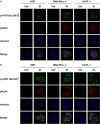Inhibiting DNA-PKcs in a non-homologous end-joining pathway in response to DNA double-strand breaks
- PMID: 28186989
- PMCID: PMC5410253
- DOI: 10.18632/oncotarget.15153
Inhibiting DNA-PKcs in a non-homologous end-joining pathway in response to DNA double-strand breaks
Abstract
DNA-dependent protein kinase catalytic subunit (DNA-PKcs) is a distinct factor in the non-homologous end-joining (NHEJ) pathway involved in DNA double-strand break (DSB) repair. We examined the crosstalk between key proteins in the DSB NHEJ repair pathway and cell cycle regulation and found that mouse embryonic fibroblast (MEF) cells deficient in DNA-PKcs or Ku70 were more vulnerable to ionizing radiation (IR) compared with wild-type cells and that DSB repair was delayed. γH2AX was associated with phospho-Ataxia-telangiectasia mutated kinase (Ser1987) and phospho-checkpoint effector kinase 1 (Ser345) foci for the arrest of cell cycle through the G2/M phase. Inhibition of DNA-PKcs prolonged IR-induced G2/M phase arrest because of sequential activation of cell cycle checkpoints. DSBs were introduced, and cell cycle checkpoints were recruited after exposure to IR in nasopharyngeal carcinoma SUNE-1 cells. NU7441 radiosensitized MEF cells and SUNE-1 cells by interfering with DSB repair. Together, these results reveal a mechanism in which coupling of DSB repair with the cell cycle radiosensitizes NHEJ repair-deficient cells, justifying further development of DNA-PK inhibitors in cancer therapy.
Keywords: DNA-PKcs; NU7441; double-strand break; nasopharyngeal carcinoma; non-homologous end-joining.
Conflict of interest statement
None.
Figures








Similar articles
-
Inactivation of DNA-PK by knockdown DNA-PKcs or NU7441 impairs non-homologous end-joining of radiation-induced double strand break repair.Oncol Rep. 2018 Mar;39(3):912-920. doi: 10.3892/or.2018.6217. Epub 2018 Jan 16. Oncol Rep. 2018. PMID: 29344644 Free PMC article.
-
Suppression of DNA-dependent protein kinase sensitize cells to radiation without affecting DSB repair.Mutat Res. 2014 Nov;769:1-10. doi: 10.1016/j.mrfmmm.2014.06.004. Epub 2014 Jun 22. Mutat Res. 2014. PMID: 25771720
-
DNA repair kinetics in SCID mice Sertoli cells and DNA-PKcs-deficient mouse embryonic fibroblasts.Chromosoma. 2017 Mar;126(2):287-298. doi: 10.1007/s00412-016-0590-9. Epub 2016 May 2. Chromosoma. 2017. PMID: 27136939 Free PMC article.
-
Mechanisms of DNA double strand break repair and chromosome aberration formation.Cytogenet Genome Res. 2004;104(1-4):14-20. doi: 10.1159/000077461. Cytogenet Genome Res. 2004. PMID: 15162010 Review.
-
DNA-Dependent Protein Kinase Catalytic Subunit: The Sensor for DNA Double-Strand Breaks Structurally and Functionally Related to Ataxia Telangiectasia Mutated.Genes (Basel). 2021 Jul 27;12(8):1143. doi: 10.3390/genes12081143. Genes (Basel). 2021. PMID: 34440313 Free PMC article. Review.
Cited by
-
Targeting DNA-dependent protein kinase sensitizes hepatocellular carcinoma cells to proton beam irradiation through apoptosis induction.PLoS One. 2019 Jun 13;14(6):e0218049. doi: 10.1371/journal.pone.0218049. eCollection 2019. PLoS One. 2019. PMID: 31194786 Free PMC article.
-
The DNA-PK Inhibitor VX-984 Enhances the Radiosensitivity of Glioblastoma Cells Grown In Vitro and as Orthotopic Xenografts.Mol Cancer Ther. 2018 Jun;17(6):1207-1216. doi: 10.1158/1535-7163.MCT-17-1267. Epub 2018 Mar 16. Mol Cancer Ther. 2018. PMID: 29549168 Free PMC article.
-
The Fanconi Anemia Pathway in Cancer.Annu Rev Cancer Biol. 2019 Mar;3:457-478. doi: 10.1146/annurev-cancerbio-030617-050422. Epub 2018 Dec 3. Annu Rev Cancer Biol. 2019. PMID: 30882047 Free PMC article.
-
Dual mTOR/DNA-PK Inhibitor CC-115 Induces Cell Death in Melanoma Cells and Has Radiosensitizing Potential.Int J Mol Sci. 2020 Dec 7;21(23):9321. doi: 10.3390/ijms21239321. Int J Mol Sci. 2020. PMID: 33297429 Free PMC article.
-
Establishment and Application of Novel Hypoxia-driven Dual-reporter Model to Investigate Hypoxic Impact on Radiation Sensitivity in Human Nasopharyngeal Carcinoma Xenografts.J Cancer. 2024 Jun 11;15(13):4345-4359. doi: 10.7150/jca.96378. eCollection 2024. J Cancer. 2024. PMID: 38947402 Free PMC article.
References
-
- Felgentreff K, Du L, Weinacht KG, Dobbs K, Bartish M, Giliani S, Schlaeger T, DeVine A, Schambach A, Woodbine LJ, Davies G, Baxi SN, van der Burg M, et al. Differential role of nonhomologous end joining factors in the generation, DNA damage response, and myeloid differentiation of human induced pluripotent stem cells. Proc Natl Acad Sci USA. 2014;111:8889–8894. - PMC - PubMed
-
- Curtin NJ. DNA repair dysregulation from cancer driver to therapeutic target. Nat Rev Cancer. 2012;12:801–817. - PubMed
-
- Foulkes WD, Shuen AY. brief: BRCA1 and BRCA2. J Pathol. 2013;230:347–349. - PubMed
MeSH terms
Substances
Grants and funding
LinkOut - more resources
Full Text Sources
Other Literature Sources
Molecular Biology Databases
Research Materials

